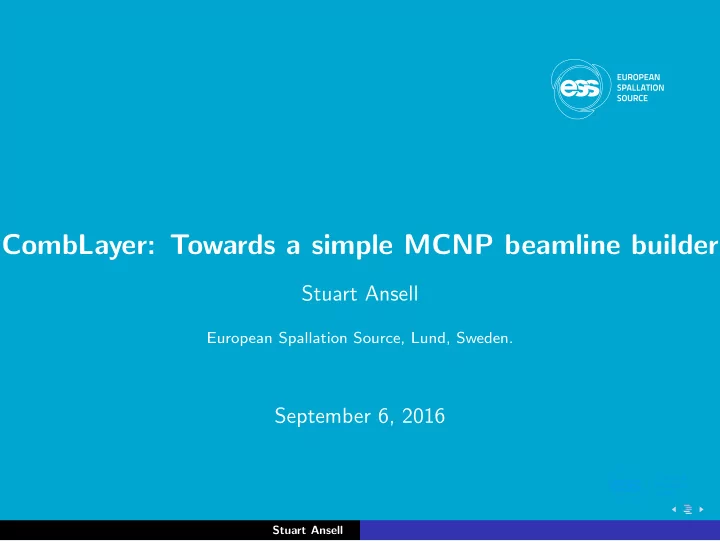

CombLayer: Towards a simple MCNP beamline builder Stuart Ansell European Spallation Source, Lund, Sweden. September 6, 2016 Stuart Ansell
Target / Reflector / Moderator Assembly / Beamlines Neutron instrument are dense, complex systems made of many high scattering materials. We have traditionally modeled them as simple objects. This is NOT a choice! – Driven by the effort required to model. Stuart Ansell
MCNP is a nightmare All of the following cause modelling difficult: Every volume needs to be described with individual quadratic surfaces. Volume needs to be completely described Surfaces like torus can only be on an axis The code is less readable than assembly code Stuart Ansell
MCNP is a nightmare All of the following help to the modeler are incomplete in the geometric algebra space and normally result in runtime penalty. Complementary cells Universes require full computation of objects within Transform cards / Lattice cards Macrobodies Boolean invariances Stuart Ansell
Requirement for CombLayer Geometry: Build a model out of complex components [like McStas] Build complex components without needing to consider anything bigger. Have a toolbox of gadgets to help build our complex components Stuart Ansell
Requirement for CombLayer Model: Output should be good to run A system of naming that allows construction without referring to numbers Tally/Variance reduction system that can use the CombLayer model Stuart Ansell
Geometry: Origins/Axis/Common surfaces FixedComp::Box box FixedComp::Plate FixedComp::ChopperHousing FixedComp::Guide plate1 DreamChopper GuideUnit2 FixedComp::Window window1 FixedComp::Bolt bolt1 LOCAL origin and axis space LOCAL surface map EXPORTS origin and axis space and link points + axes Stuart Ansell
Multile Direction linkage Linkage followed by Rotation/Offset Start point - End Point linkage system Stuart Ansell
Evolution of object/object intersection Consider an Region of objects that needs to overlap and exclude a portion of another region of objects. The overlap region is defined in green. CombLayer adds union of orange surfaces to blue cells Improves runtime by ∼ (NSurf orange / NIter) 2 Stuart Ansell
Bunker Wall Layout Have the ability to make any cell discrete (3D) The material for each cell/cells are then read from an XML file Division allows cell-bases variance reduction Stuart Ansell
BunkerWall code 1 void Bunker :: createMainWall ( Simulation& System) 2 { 3 ELog :: RegMethod RegA("Bunker"," createMainWall "); 4 size_t AS= activeSegment ; // binary system 5 for(size_t i=0; AS && i<nSectors;i++) 6 { 7 const std :: string CName="Sector"+StrFunc :: makeString(i); 8 if (AS & 1) 9 { 10 const int CN=getCell("frontWall",i); 11 ModelSupport :: LayerDivide3D LD3(keyName+"MainWall"+ 12 StrFunc :: makeString (i)); 13 14 LD3. setSurfPair (0,SMap.realSurf(bnkIndex +1001+ static_cast <int >(i)), 15 SMap.realSurf(bnkIndex +1002+ static_cast <int >(i))); 16 17 LD3. setSurfPair (1,SMap.realSurf(bnkIndex +5), 18 SMap.realSurf(bnkIndex +6)); 19 LD3. setSurfPair (2,SMap.realSurf(bnkIndex +7), 20 SMap.realSurf(bnkIndex +17)); 21 LD3. setFractions (0, segDivide ); 22 LD3. setFractions (1, vertFrac ); 23 LD3. setFractions (2, wallFrac ); 24 25 LD3. setMaterialXML (keyName+"Def.xml","WallMat",keyName+".xml", 26 ModelSupport :: EvalMatString (wallMat )); 27 LD3. divideCell(System ,CN); 28 removeCell ("frontWall",i); 29 addSurfs(CName ,LD3.getSurfs ()); 30 addCells(CName ,LD3.getCells ()); 31 } 32 AS > >=1; 33 } 34 return; Stuart Ansell 35 }
Specialized Link Units: Pipework CombLayer allows pipework using object that have links and free points Any convex profile is acceptable Multi-layer joins done for all object inherited from LayerComp Multi layer link joins Stuart Ansell
Variance reduction: Semi-Adjoint processing Create the object C 11 C 21 C 31 C 41 connections Calculate the attenuation and 1 / r w C 12 C 22 C 32 C 42 from cell centre to cell centre for each Evolve the Markov C 13 C 23 C 33 C 43 Chain cell interaction probability C 14 C 24 C 34 C 44 Use result as w ij component. Stuart Ansell
Variance reduction: Long beamlins Long beamline need to exploit angular biasing Auto-determined ext card on a cell/cell level Benefits from LD3 splitting Stuart Ansell
Conclusions We have tools to process complex geometries In a position to offer fast target to sample calculations Code/Build your model at a level away from MCNP Download https://gitbug.com/SAnsell/CombLayer Stuart Ansell
Recommend
More recommend